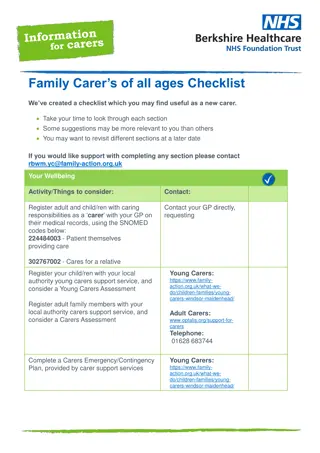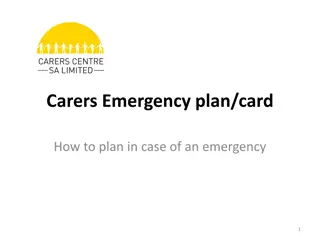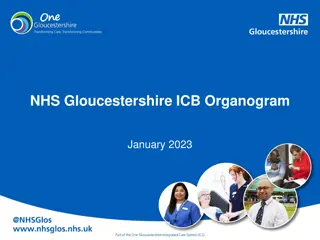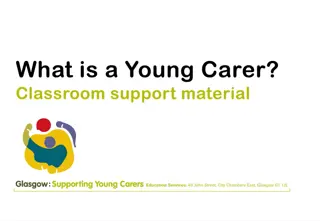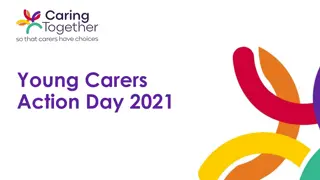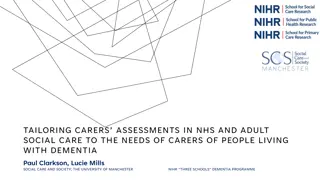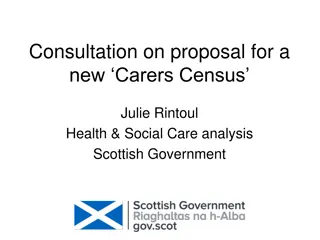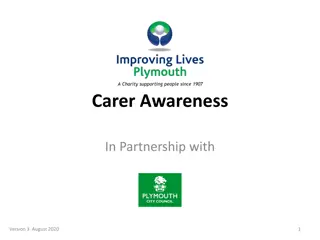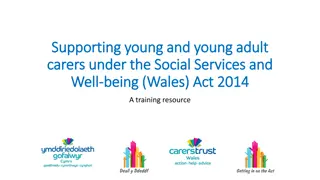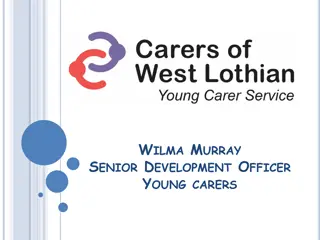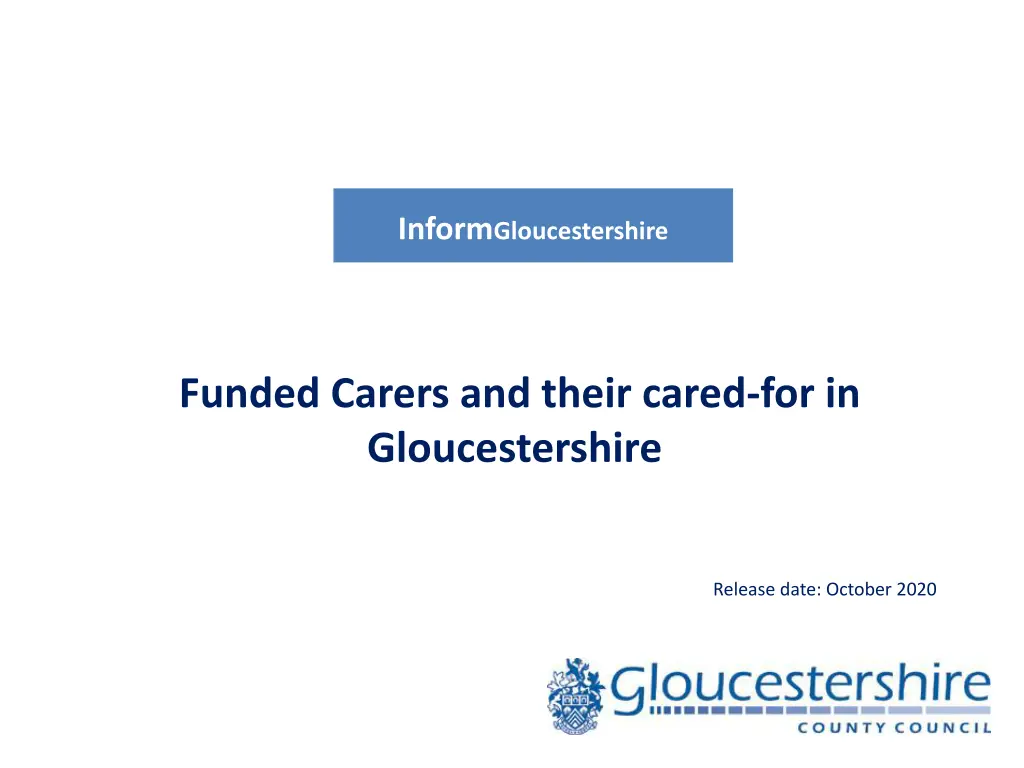
Gloucestershire Funded Carers and Key Trends Report
Explore key trends in funded carers and their cared-for in Gloucestershire based on data from Gloucestershire County Council's database. Discover insights on carer demographics, services used, and changes in numbers over the years.
Download Presentation

Please find below an Image/Link to download the presentation.
The content on the website is provided AS IS for your information and personal use only. It may not be sold, licensed, or shared on other websites without obtaining consent from the author. If you encounter any issues during the download, it is possible that the publisher has removed the file from their server.
You are allowed to download the files provided on this website for personal or commercial use, subject to the condition that they are used lawfully. All files are the property of their respective owners.
The content on the website is provided AS IS for your information and personal use only. It may not be sold, licensed, or shared on other websites without obtaining consent from the author.
E N D
Presentation Transcript
InformGloucestershire Funded Carers and their cared-for in Gloucestershire Release date: October 2020
Funded carers and the cared-for: Key Trends All analysis in this report is based on data recorded on Gloucestershire County Council's database ERIC. The number of carers receiving services at 31 March was: 1252 in 2018 950 in 2019: a decrease of 24.1% from 31 March 2018 1093 in 2020: an increase of 15.1% from 31 March 2019 The broad age groups of carers at 31 March 2020 were: 0-64 (264 or 24.2%): 65+ (816 or 74.7%): Unknown (13 or 1.2%): a decrease of 7.1% from 31 March 2019 an increase of 16.8% from 31 March 2019 an increase of 14.9% from 31 March 2019 The four largest age groups of carers at 31 March 2020, which accounted for 94.0% of all carers, were: 75-84 (28.5%): an increase of 18.2% from 31 March 2019 65-74 (24.9%): an increase of 15.7% from 31 March 2019 85+ (21.2%): an increase of 10.0% from 31 March 2019 45-64 (19.3%): an increase of 22.7% from 31 March 2019 The three services most-used by the cared-for at 31 March 2020 were: Physical support (822 or 78.3%): Support with memory and cognition (76 or 7.2%): a decrease of 14.6% from 31 March 2019 Learning disability support (50 or 4.8%): an increase of 17.3% from 31 March 2019 a decrease of 9.1% from 31 March 2019
Carers: Snapshot as at 31 March 2020 Number of carers Carer_AgeGroup Under 18 18-24 25-44 45-64 65-74 75-84 85+ Unknown Grand Total 31-Mar-20 % 31-Mar-20 2 9 42 211 272 312 232 13 1093 0.2% 0.8% 3.8% 19.3% 24.9% 28.5% 21.2% 1.2% 100.0% Number of carers District Cheltenham Cotswold Forest of Dean Gloucester Stroud Tewkesbury (blank) Grand Total 31-Mar-20 % 31-Mar-20 170 164 159 234 208 147 11 1093 15.6% 15.0% 14.5% 21.4% 19.0% 13.4% 1.0% 100.0% Number of carers Age gap group 70+ years younger 42-69 years younger 14-41 years younger 13 years younger to 14 years older 15-42 years older 43-70 years older Unknown N/A (no cared-for details) Grand Total Age gap generation Over two generations younger Two generations younger One generation younger Same generation One generation older Two generations older 31-Mar-20 % 31-Mar-20 2 5 193 729 103 7 11 43 1093 0.2% 0.5% 17.7% 66.7% 9.4% 0.6% 1.0% 3.9% 100.0% Number of carers Carer_Gender Female Male Unknown Grand Total 31-Mar-20 % 31-Mar-20 681 374 38 1093 62.3% 34.2% 3.5% 100.0%
Carers: Number The number of carers receiving services at 31 March was: 1252 in 2018 950 in 2019: A decrease of 24.1% from 2018 1093 in 2020: An increase of 15.1% from 2019 Snapshot 31-Mar-18 31-Mar-19 31-Mar-20 % change '18 to '19 % change '19 to '20 Number of carers 1252 950 1093 -24.1% 15.1%
Carers: Age group Of those carers using services at 31 March 2020 three-quarters (74.7%) were 65 or over and a quarter (24.2%) were under 65. In the same snapshot: Just under a third (28.5%) were aged 75-84 A further quarter (24.9%) were aged 65-74. Just over a fifth (21.2%) were aged 85 or over Just under a fifth (19.3%) were aged 45-64 The remaining 6% were aged under 45 or of unknown age. There was little year-on-year variation in the percentage of carers in each age group. Number of carers Carer_AgeGroup Under 18 18-24 25-44 45-64 65-74 75-84 85+ Unknown Grand Total Snapshot 31-Mar-18 Snapshot 31-Mar-19 31-Mar-20 % 31-Mar-18 % 31-Mar-19 % 31-Mar-20 % change '18 to '19 % change '19 to '20 1 2 0.1% 0.1% 9 9 0.9% 0.9% 44 42 4.6% 4.6% 172 211 20.5% 18.1% 235 272 23.9% 24.7% 264 312 28.1% 27.8% 211 232 20.4% 22.2% 14 13 1.6% 1.5% 950 1093 100.0% 100.0% 1 0.2% 0.8% 3.8% 19.3% 24.9% 28.5% 21.2% 1.2% 100.0% 0.0% -18.2% -22.8% -33.1% -21.4% -25.0% -17.3% -30.0% -24.1% 100.0% 0.0% -4.5% 22.7% 15.7% 18.2% 10.0% -7.1% 15.1% 11 57 257 299 352 255 20 1252
Carers: Gender Carers are more likely to be female than male. At 31 March 2020, of carers using services: The majority (62.3%) were female Just over a third (34.2%) were male The gender of the rest (3.5%) was unknown. These proportions have remained about the same as for the 2018 and 2019 snapshots. Number of carers Carer_Gender Snapshot 31-Mar-18 31-Mar-19 31-Mar-20 % 31-Mar-18 % 31-Mar-19 % 31-Mar-20 % change % change '19 to '20 13.3% 11.3% 192.3% 15.1% '18 to '19 -23.6% -25.3% -13.3% -24.1% Female Male Unknown Grand Total 787 450 15 1252 601 336 13 950 681 374 38 1093 62.9% 35.9% 1.2% 100.0% 63.3% 35.4% 1.4% 100.0% 62.3% 34.2% 3.5% 100.0%
Carers: District On 31 March 2020: Gloucester had the highest number of carers, accounting for just over a fifth (21.4%) of the total. Stroud was next (19.0%) followed by Cheltenham (15.6%) then Cotswold (15.0%). Tewkesbury had the fewest carers (13.4%). 11 carers (1%) could not be matched to a district. All districts had fewer carers than at 31 March 2018 but the percentage of carers in each district remained about the same as in previous snapshots. Number of carers District Cheltenham Cotswold Forest of Dean Gloucester Stroud Tewkesbury (blank) Grand Total Snapshot 31-Mar-18 31-Mar-19 31-Mar-20 % District '18 % District '19 % District '20 % change '18 to '19 % change '19 to '20 197 140 170 15.7% 14.7% 165 129 164 13.2% 13.6% 191 137 159 15.3% 14.4% 272 216 234 21.7% 22.7% 223 181 208 17.8% 19.1% 187 137 147 14.9% 14.4% 17 10 11 1.4% 1.1% 1252 950 1093 100.0% 100.0% 15.6% 15.0% 14.5% 21.4% 19.0% 13.4% 1.0% 100.0% -28.9% -21.8% -28.3% -20.6% -18.8% -26.7% -41.2% -24.1% 21.4% 27.1% 16.1% 8.3% 14.9% 7.3% 10.0% 15.1%
Carers: Age gap (age of carer less age of cared-for) In the chart below you can see there are three main peaks, roughly corresponding to those caring for the younger generation, their own generation and the older generation. Of all carers: Most carers (66.2%) care for someone of the same generation (13 years younger to 14 years older) 17.4% care for someone a generation younger (14 to 41 years younger) 10.7% care for someone a generation older (15-42 years older) Age gap group (generation) No. carers % carers 4 0.1% 14 0.4% 572 17.4% 2181 66.2% 351 10.7% 26 0.8% 108 3.3% 39 1.2% 3295 100% 70+ years younger 42-69 years younger 14-41 years younger 13 years younger to 14 years older 15-42 years older 43-70 years older N/A (no cared-for data) Unknown Grand Total * A generation is 28 years for the purpose of this analysis.
Carers: Comparison of snapshots as at 31 March 2018, 2019 and 2020 This slide looks at the percentage of carers in each key group at 31 March 2018, 2019 and 2020. It allows comparison of the snapshots for each year. There is little year-on-year variation in the percentage of carers in each gender, age, or district group.
Carers: Comparison of snapshots as at 31 March 2018, 2019 and 2020 This slide and the following slide look at the percentage of cared-for in each age group looked after by carers in a single age group. It allows comparison of the snapshots for each year. There is little year on year variation in the percentage of each cared-for age group looked after by each carer age group. Carers aged 85 and over, 75-84 and 18-24 (see next slide) are the most likely to look after someone close to their own age.
Carers: Comparison of snapshots as at 31 March 2018, 2019 and 2020 There is little year on year variation in the percentage of each cared-for age group looked after by each carer age group. Carers aged 45-64 look after the widest range of cared-for age groups.
The cared-for: Number The number of cared-for receiving services at 31 March was: 1218 in 2018 919 in 2019: A decrease of 24.5% from 2018 1050 in 2020: An increase of 14.31% from 2019 There are fewer cared-for than carers as not all carers in ERIC are linked to the person they care for. Snapshot 31-Mar-18 31-Mar-19 31-Mar-20 % change '18 to '19 1050 % change '19 to '20 Number cared-for 1218 919 -24.5% 14.3%
The cared-for: Age group Of those cared-for using services at 31 March 2020 four fifths (79.4%) were over 65 and a fifth (20.4%) were under 65. In the same snapshot: A third (33.4%) were aged 85 or over A further third (32.2%) were aged 75-84. 145 (13.8%) were aged 65-74. 139 (13.2%) were 45-64 The remaining 7.3% were under 44 or of unknown age. The proportion of cared-for in each age group remained similar from year to year. Number cared-for Snapshot % change '18 to '19 -47.1% -34.4% -18.3% -19.8% -25.4% -27.1% -22.7% -33.3% -24.5% % change '19 to '20 Cared-for age group Under 18 18-24 25-44 45-64 65-74 75-84 85+ Unknown Grand Total 31-Mar-18 31-Mar-19 31-Mar-20 % 31-Mar-18 % 31-Mar-19 % 31-Mar-20 17 9 9 32 21 21 60 49 45 167 134 139 185 138 145 384 280 338 370 286 351 3 2 2 1218 919 1050 1.4% 2.6% 4.9% 13.7% 15.2% 31.5% 30.4% 0.2% 100.0% 1.0% 2.3% 5.3% 14.6% 15.0% 30.5% 31.1% 0.2% 100.0% 0.9% 2.0% 4.3% 13.2% 13.8% 32.2% 33.4% 0.2% 100.0% 0.0% 0.0% -8.2% 3.7% 5.1% 20.7% 22.7% 0.0% 14.3%
The cared-for: Gender In contrast to carers, the cared-for are more likely to be male than female. At 31 March 2020, of people cared-for using services: Over half (560 or 53.3%) were male Under half (478 or 45.5%) were female The gender of the rest (1.1%) was unknown. These proportions have remained about the same as for the 2018 and 2019 snapshots. Number cared-for Caredfor_gender Snapshot 31-Mar-18 31-Mar-19 31-Mar-20 % 31-Mar-18 % 31-Mar-19 % 31-Mar-20 %Change %Change '19 to '20 11.4% 15.7% 100.0% 14.3% '18 to '19 -27.9% -21.6% Female Male Unknown Grand Total 595 617 429 484 478 560 12 1050 48.9% 50.7% 0.5% 100.0% 46.7% 52.7% 0.7% 100.0% 45.5% 53.3% 1.1% 100.0% 6 6 0.0% -24.5% 1218 919
The cared-for: Primary support reason group The three most used services by people being cared-for are physical support, support with memory and cognition and learning disability support. These account for 90.3% of the services used. 822 cared-for people were using physical support services at 31 March 2020. This number has increased by 17.3% from 701 at 31 March 2019. 76 cared-for people were using support with memory and cognition at 31 March 2020. This number has decreased by 14.6% since 31 March 2019. 50 cared-for people were using learning disability support 31 March 2020. This number has decreased by 9.1% since 31 March 2019. There was an increase in cared-for people using sensory support, from 33 at 31 March 2019 to 44 at 31 March 2020 (+33.3%). The number of cared-for people using social support stayed the same (13) as did the number getting mental health support (5) in the same period. Number cared-for Cared-for Primary support reason group Physical Memory and cognition Learning Disability Sensory Social Mental Health (blank) Grand Total % 31-Mar-18 % 31-Mar-19 % 31-Mar-20 75.9% 11.1% 5.7% 3.2% 1.1% 0.5% 2.5% 100.0% 76.3% 9.7% 6.0% 3.6% 1.4% 0.5% 2.5% 100.0% 78.3% 7.2% 4.8% 4.2% 1.2% 0.5% 3.8% 100.0%
The cared-for: Primary support reason group Top 3 Primary support reason groups: On 31 March each year, of the total number of cared-for: Over 75% were receiving physical support. This varied from 924 (75.9%) in 2018, 701 (76.3%) in 2019 and 822 (78.3%) in 2020. The number and percentage receiving support with memory and cognition varied from 135 (11.1%) in 2018 to 89 (9.7%) in 2019 and 76 (7.2%) in 2020. Around 5% were receiving learning disability support. This varied from 70 (5.7%) in 2018 to 55 (6.0%) in 2019 and 50 (4.8%) in 2020. Cared-for by Primary support reason group - Memory and cognition Cared-for by Primary support reason group - Learning Disability 200 100 100 50 70 135 31-Mar-18 31-Mar-18 89 76 55 50 0 0 31-Mar-19 31-Mar-19 Memory and cognition Learning Disability
The cared-for: Primary support reason group Next 3 Primary support reason groups On 31 March each year, of the total number of cared- for: Under 5% were receiving sensory support. This varied from 39 (3.2%) in 2018 to 33 (3.6%) in 2019 and 44 (4.2%) in 2020. 13 were receiving social support. This was 1.1% in 2018, 1.4% in 2019 and 1.2% in 2020. 0.5% were receiving mental health support. This was 6 in 2018 and 5 in 2019 and 2020.
Links Carer Survey report Resources The Carer Survey report sets out the key findings of the Carer Survey 2018/19 for Gloucestershire. Carers Trust offers a wide range of resources for anyone who works with carers.


